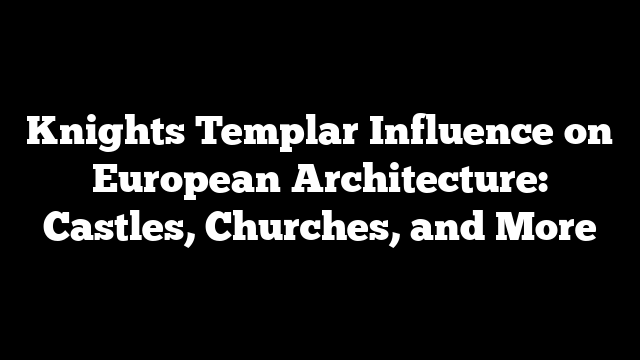The Knights Templar, a powerful group from the 12th century, changed medieval Europe‘s architecture. Their style came from the Middle East and is seen in famous castles and churches. This article will look at how they shaped European architecture during their time.
The Templars were known for their bravery and faith. They wanted to spread their influence across Europe. They put their unique style into the buildings they made or helped make. This includes everything from strong castles to beautiful churches. Their work can still be seen all over Europe today.
Key Takeaways
- The Knights Templar had a big effect on European architecture, especially in making castles and religious buildings.
- Their style, influenced by the Middle East, is seen in the design and look of their buildings.
- Important Templar castles and strongholds, like the Convent of Christ in Tomar, Portugal, and Château Pélissier in France, show their big impact on architecture.
- Templar churches, like the Church of the Knights Templar in London, show their focus on religious buildings and their effect on design.
- The Templar’s lasting architectural legacy is still studied by historians and architects today, showing their big influence.
The Rise of the Knights Templar
The Knights Templar started in 1119 AD. A group of French knights came together in Jerusalem. They wanted to protect Christian pilgrims going to the Holy Land. Over two centuries, they became very famous and powerful in the Middle Ages.
Origins and Early Years
A small group of French knights, led by Hugues de Payens, started the Knights Templar. They made a promise to protect pilgrims on their way to the Holy Land. They named their group after their base in Jerusalem, the Temple Mount. They lived a simple life, promising to be poor, chaste, and obedient. They focused on protecting pilgrims.
Templar Military Campaigns
The Knights Templar became a strong military group. They played a big part in the Crusades and defending the Crusader states. Their warriors were skilled and used the latest technology. They won many battles for the Christians.
The Templars’ military history and expansion changed the Middle East and Europe. They built many castles and helped the Crusader states. They were also good at managing money and banking, which made them very powerful in Europe.
- The Templars’ military skills and tactics helped the Crusades succeed.
- Their castles and strong places helped keep the Crusader states safe.
- The Templars were smart with money and banking, which made them very influential.
The Knights Templar were more than a religious order. They were a well-organized and powerful military group. They changed history during the Crusades and the Middle Ages.
Templar Architecture Style
The Knights Templar’s architecture was shaped by their time in the Middle East. They mixed Eastern and Western designs. This made their buildings stand out.
The Templar architectural style had some key features:
- Rounded towers for better defense and watching over the area
- Strong walls to resist attacks
- Arrow slits for fighting from a distance
The Templars used their military skills in building. They used vaulted ceilings and strong walls. This made their buildings look good and last long.
Their buildings, like castles and churches, show their unique style. This style mixed Eastern and Western designs. It looks amazing and still inspires people today.
“The Templar architectural style was a testament to the order’s military might and engineering prowess, seamlessly blending the best of Eastern and Western design traditions.”
Iconic Templar Castles and Fortifications
The Knights Templar were known for their amazing building skills. They built many castles and fortifications in Europe and the Middle East. The Convent of Christ in Tomar, Portugal, and the Château Pélissier in France are two great examples.
Convent of Christ in Tomar, Portugal
The Convent of Christ in Tomar, Portugal, is a key Templar fortress. It combines defense with religious buildings. Built in the 12th century, it has strong stone walls, towers, and a round keep.
These were made to resist attacks and keep the Templar knights safe. In the middle, the Templar church stands. It’s a beautiful building that shows the order’s unique style.
Château Pélissier in France
In France, the Château Pélissier is another Templar fortification. It was built in the 13th century and has many defensive features. These include thick walls, towers, and a moat.
But it’s not just for fighting. The Château Pélissier also has a Templar chapel. This shows the order’s role as both warriors and devout Christians.
These Templar castles and fortifications show the Knights Templar’s amazing building skills. They also show their strong faith. They are lasting reminders of the order’s legacy.
Templar architecture influence
The Knights Templar changed European architecture in big ways. Their unique style and building methods were copied a lot. This made the Romanesque and Gothic styles popular in many famous buildings.
Distinctive Features and Techniques
The Templars built with round towers, thick walls, and arrow slits. These designs were copied by others. This look became common in castles, monasteries, and cathedrals across Europe.
The Templars were also great at building. They knew a lot about stonework, vaulting, and engineering. This helped create Gothic cathedrals with tall arches and detailed facades.
- Adoption of Templar architectural elements, such as round towers and arrow slits, in military and religious buildings
- Influence on the Romanesque and Gothic styles, including the design of cathedrals and monasteries
- Templar expertise in engineering and construction techniques that advanced the field of architecture
“The Templars’ architectural legacy can be seen in the enduring impact of their building techniques and design choices, which continue to shape the landscape of Europe to this day.”
The Templars left a big mark on European architecture. Their style and building methods changed the look of the continent. They helped create some of Europe’s most famous and lasting buildings.
Templar Churches and Religious Buildings
The Knights Templar left a lasting mark in medieval Europe’s religious architecture. The Church of the Knights Templar in London is a prime example. It was a place of worship and showed the Templars’ strong faith and their role protecting Christian pilgrims.
The Church in London is famous for its round shape. This design was common in Templar churches. It symbolized life’s cycles and the endless quest for spiritual growth. The church also had beautiful carvings and stained-glass windows. These showed the Templars’ love for art and their deep faith.
But the Templars’ impact wasn’t just in London. Many Templar churches and buildings across Europe stood as symbols of their faith. They were not just for worship. They also helped the Templars manage their spiritual and worldly affairs with great care.



